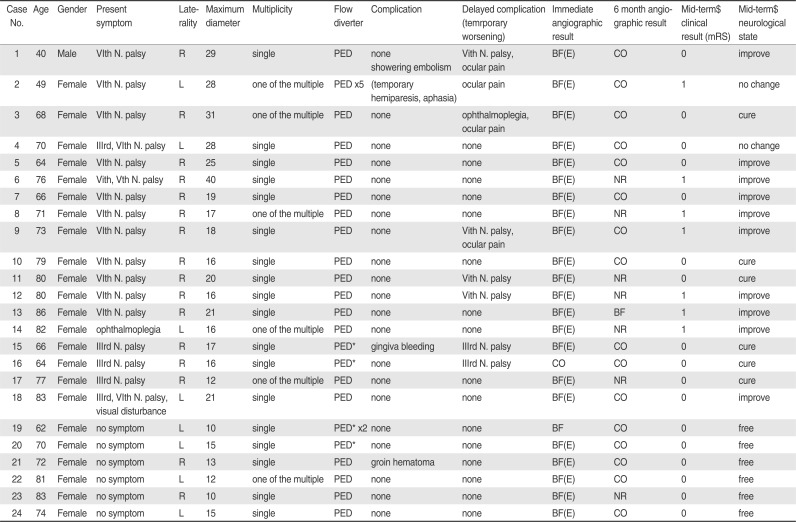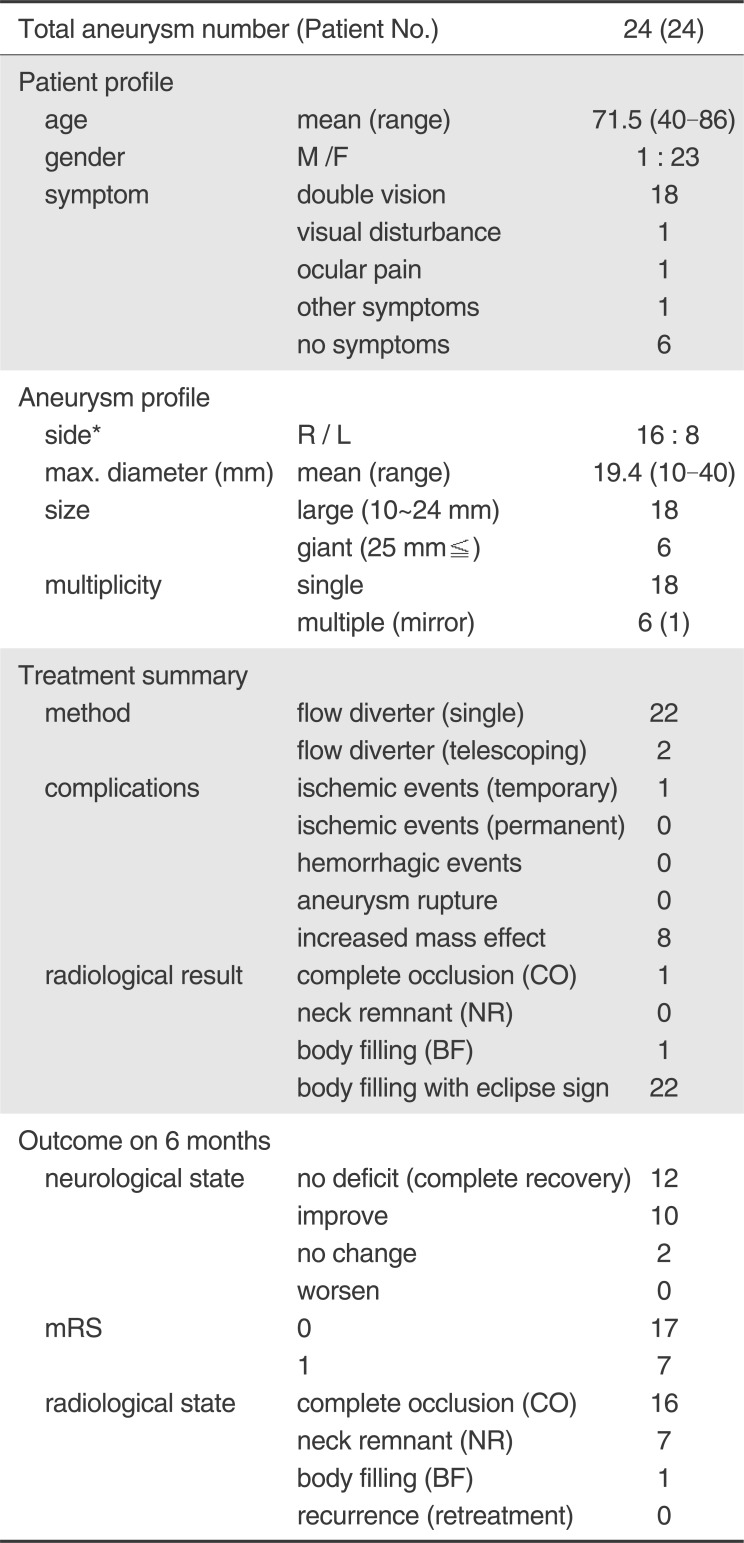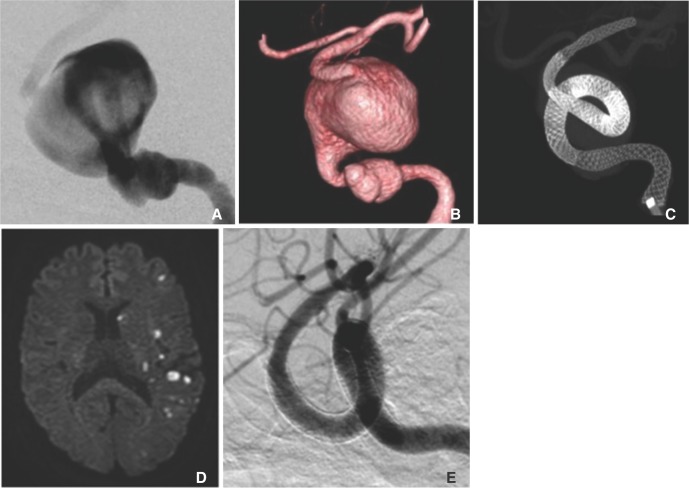1. van Rooij WJ. Endovascular treatment of cavernous sinus aneurysms. AJNR Am J Neuroradiol. 2012; 33:323–326. PMID:
22033713.

2. Chalouhi N, Tjoumakaris S, Dumont AS, Gonzalez LF, Randazzo C, Starke RM, et al. Treatment of posterior circulation aneurysms with the pipeline embolization device. Neurosurgery. 2013; 72:883–889. PMID:
23407289.

3. Lylyk P, Miranda C, Ceratto R, Ferrario A, Scrivano E, Luna HR, et al. Curative endovascular reconstruction of cerebral aneurysms with the pipeline embolization device: the Buenos Aires experience. Neurosurgery. 2009; 64:632–642. PMID:
19349825.
4. Nelson PK, Lylyk P, Szikora I, Wetzel SG, Wanke I, Fiorella D. The pipeline embolization device for the intracranial treatment of aneurysms trial. AJNR Am J Neuroradiol. 2011; 32:34–40. PMID:
21148256.

5. Saatci I, Yavuz K, Ozer C, Geyik S, Cekirge HS. Treatment of intra- cranial aneurysms using the pipeline flow-diverter embolization device: a single-center experience with long-term follow-up results. AJNR Am J Neuroradiol. 2012; 33:1436–1446. PMID:
22821921.
6. Miyachi S. Tactics, Techniques and Spirits of Neuroendovascular Therapy. - Miyachi's style, Chapter Skill-A Aneurysm -flow diverter-. Osaka: Medica Shuppan;2015. p. 164–169. (in Japanese).
7. Roy D, Milot G, Raymond J. Endovascualar treatment of unruptured aneurysms. Stroke. 2001; 32:1998–2004. PMID:
11546888.
8. Puffer RC, Piano M, Lanzino G, Valvassori L, Kallmes DF, Quilici L, et al. Treatment of cavernous sinus aneurysms with flow diversion: results in 44 patients. AJNR Am J Neuroradiol. 2014; 35:948–951. PMID:
24356675.

9. Zanaty M, Chalouhi N, Starke RM, Barros G, Saigh MP, Schwartz EW, et al. Flow diversion versus conventional treatment for carotid cavernous aneurysms. Stroke. 2014; 45:2656–2661. PMID:
25052318.

10. Briganti F, Napoli M, Tortora F, Solari D, Bergui M, Boccardi E, et al. Italian multicenter experience with flow-diverter devices for intracranial unruptured aneurysm treatment with periprocedural complications--a retrospective data analysis. Neuroradiology. 2012; 54:1145–1152. PMID:
22569955.

11. O'Kelly CJ, Spears J, Chow M, Wong J, Boulton M, Weill A, et al. Canadian experience with the pipeline embolization device for repair of unruptured intracranial aneurysms. AJNR Am J Neuroradiol. 2013; 34:381–387. PMID:
22859284.
12. Lanzino G, Crobeddu E, Cloft HJ, Hanel R, Kallmes DF. Efficacy and safety of flow diversion for paraclinoid aneurysms: a matched-pair analysis compared with standard endovascular approaches. AJNR Am J Neuroradiol. 2012; 33:2158–2161. PMID:
22790243.

13. Chalouhi N, Tjoumakaris S, Starke RM, Gonzalez LF, Randazzo C, Hasan D, et al. Comparison of flow diversion and coiling in large unruptured intracranial saccular aneurysms. Stroke. 2013; 44:2150–2154. PMID:
23723311.

14. Becske T, Kallmes DF, Saatci I, McDougall CG, Szikora I, Lanzino G, et al. Pipeline for uncoilable or failed aneurysms: results from a multicenter clinical trial. Radiology. 2013; 267:858–868. PMID:
23418004.

15. Kallmes DF, Hanel R, Lopes D, Boccardi E, Bonafé A, Cekirge S, et al. International retrospective study of the Pipeline embolization device: a multicenter aneurysm treatment study. AJNR Am J Neuroradiol. 2015; 36:108–115. PMID:
25355814.

16. Raymond J, Darsaut TE, Kotowski M, Makoyeva A, Gevry G, Berthelet F, et al. Thrombosis heralding aneurysmal rupture: an exploration of potential mechanisms in a novel giant swine aneurysm model. AJNR Am J Neuroradiol. 2013; 34:346–353. PMID:
23153870.

17. Maruta K, Aoki A, Omoto T, Iizuka H, Kawaura H. The Effect of Steroid Therapy on Postoperative Inflammatory Response after Endovascular Abdominal Aortic Aneurysm Repair. Ann Vasc Dis. 2016; 9:168–172. PMID:
27738457.

18. Miyachi S, Ohnishi H, Hiramatsu R, Izumi T, Matsubara N, Kuroiwa T. Innovations in Endovascular Treatment Strategies for Large Carotid Cavernous Aneurysms-The Safety and Efficacy of a Flow Diverter. J Stroke Cerebrovasc Dis. 2017; 26:1071–1080. PMID:
28238529.

19. Guédon A, Clarençon F, Di Maria F, Rosso C, Biondi A, Gabrieli J, et al. Very late ischemic complications in flow-diverter stents: a retrospective analysis of single-center series. J Neurosurg. 2016; 125:929–935. PMID:
26824382.
20. Miyachi S, Ishii A. Development of a Pipeline-classic Type to Flex: Points of Improvement and Precautions for Use. J Neuroendovascular Ther. 2016; 26:1071–1080.

21. Park MS, Albuquerque FC, Nanaszko M, Sanborn MR, Moon K, Abla AA, et al. Critical assessment of complications associated with use of the Pipeline Embolization Device. J Neurointerv Surg. 2015; 7:652–659. PMID:
24968879.

22. Kim BM, Shin YS, Baik MW, Lee DH, Lee TH, Kang DH, et al. Pipeline Embolization Device for Large/Giant or Fusiform Aneurysms: An Initial Multi-Center Experience in Korea. Neurointervention. 2016; 11:10–17. PMID:
26958407.










 PDF
PDF ePub
ePub Citation
Citation Print
Print


 XML Download
XML Download